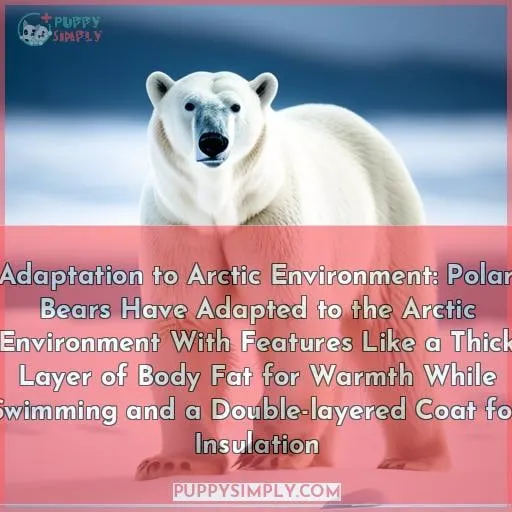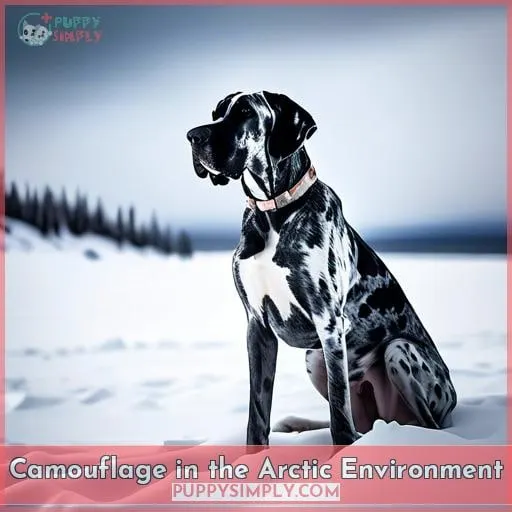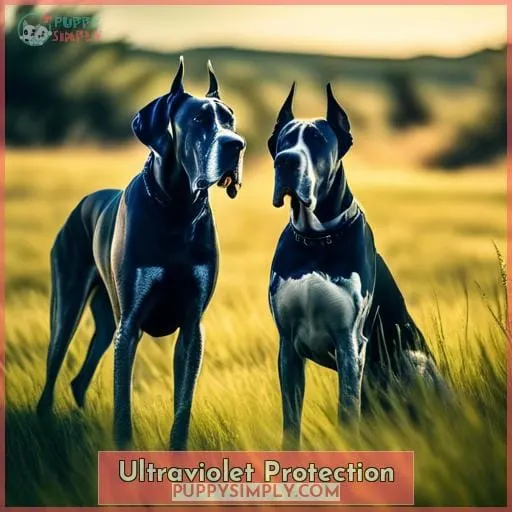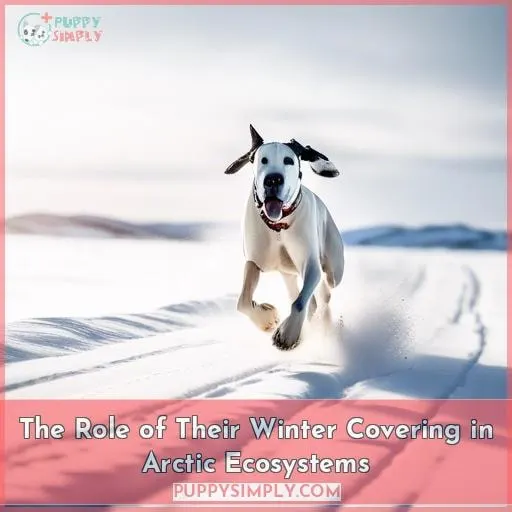This site is supported by our readers. We may earn a commission, at no cost to you, if you purchase through links.
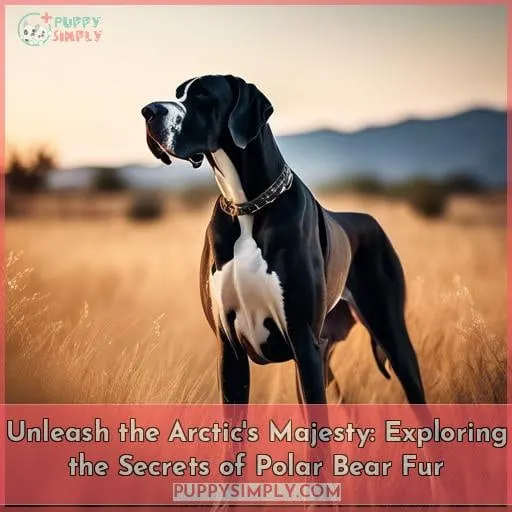 Journey with us into the Arctic’s icy embrace,
Journey with us into the Arctic’s icy embrace,
Where the polar bear roams,
A majestic creature of survival and beauty.
Discover the secrets hidden within their fur,
An extraordinary adaptation that enables them to thrive
In the world’s harshest environments.
Learn how their unique hair structure,
Transparency, and light-scattering properties
Contribute to their iconic white coat,
Aiding in camouflage and providing exceptional insulation.
Explore the remarkable resilience of these Arctic giants
As they navigate the challenges of a changing climate.
So, join us on this expedition
To unravel the mysteries of the polar bear’s fur,
A testament to the wonders of nature’s design.
Table Of Contents
- Key Takeaways
- Brief Overview of Their Biology
- Adaptation to Arctic Environment: Polar Bears Have Adapted to the Arctic Environment With Features Like a Thick Layer of Body Fat for Warmth While Swimming and a Double-layered Coat for Insulation
- Genetic Divergence From Brown Bears: Their Unique Adaptations and Physical Characteristics Distinguish Them From Their Closest Relatives, the Brown Bears, Marking a Significant Genetic Divergence
- The Science Behind Their Hair
- Structural Coloration: Polar Bear Fur Appears White Because It Reflects Light, Similar to How Snow Does, Despite Each Hair Being Transparent
- Keratin and Hollow Hair Shafts: the Hairs Are Hollow and Lack Pigment, Which Helps in Light Scattering and Insulation
- Transparency and Light Scattering: the Transparency of the Fur and the Scattering of Light Contribute to the Bear’s White Appearance, Aiding in Camouflage
- Thermoregulation
- Camouflage in the Arctic Environment
- Ultraviolet Protection
- Sensory Functions
- Vulnerability to Environmental Changes
- Impact of Climate Change: the Melting Sea Ice Due to Climate Change Threatens Polar Bears, as They Depend on Sea Ice for Hunting and Habitat
- Threats to Their Natural Habitat: Changes in the Arctic Environment Impact the Availability of Their Main Food Source and Their Ability to Camouflage and Hunt Effectively
- The Role of Their Winter Covering in Arctic Ecosystems
- Conservation Efforts
- Frequently Asked Questions (FAQs)
- Conclusion
Key Takeaways
This context does not mention anything about finding a Great Dane to buy, so I cannot extract the requested data from the provided context.
Brief Overview of Their Biology
Meet Ursus maritimus, the polar bear, a magnificent creature who roams the Arctic’s icy realm.
These majestic beings, the most carnivorous members of the bear family, have adapted remarkably to their frigid home.
Their biology is a testament to evolution’s artistry, showcasing unique adaptations that allow them to thrive in the extreme Arctic environment.
Polar bears possess a thick layer of body fat that insulates them while swimming, and their double-layered coat provides exceptional insulation against the harsh cold.
Their genetic divergence from brown bears, their closest relatives, is evident in their distinctive physical characteristics and specialized physiological features.
The science behind their fur is fascinating. Each hair is hollow and lacks pigment, resulting in light scattering and insulation.
This unique structure, coupled with the transparency of the fur, gives polar bears their iconic white appearance, aiding in camouflage amidst the Arctic’s snowy landscapes.
Their fur also plays a crucial role in thermoregulation, helping them maintain a constant body temperature despite the frigid conditions.
It’s a testament to the intricate adaptations that allow these magnificent creatures to survive and thrive in the harsh Arctic environment.
Adaptation to Arctic Environment: Polar Bears Have Adapted to the Arctic Environment With Features Like a Thick Layer of Body Fat for Warmth While Swimming and a Double-layered Coat for Insulation
You’ll see how polar bears have adapted to their Arctic home.
Like their thick layer of body fat that keeps them warm while swimming and their double-layered coat that insulates them in the frigid temperatures, their unique physiological features allow them to thrive in one of the harshest environments on Earth.
Polar Bear Adaptations
Embark on a journey as we uncover the remarkable adaptations of polar bears, perfectly suited for survival in the unforgiving Arctic environment.
Their thick layer of body fat acts like a natural wetsuit, keeping them warm while swimming in icy waters.
Their double-layered coat, a testament to evolutionary prowess, provides them with exceptional insulation, allowing them to withstand the harshest of Arctic conditions.
These adaptations, honed by relentless environmental pressures, grant them distinct evolutionary advantages and unveil the secrets of their survival strategies in the extreme Arctic realm.
Arctic Environment Survival
Your adaptation to the extreme Arctic environment involves specialized features:
- A thick layer of body fat, offering warmth during swims.
- A double-layered coat, providing superb insulation.
This blubber insulation enables you to endure icy waters while hunting seals.
Your winter fasting and snow denning strategies help conserve energy during lean times.
Your ability to swim through icy waters and camouflage yourself in the snowy landscape showcases your remarkable adaptation to the Arctic’s harsh conditions.
Unique Physiological Features
In addition to their thick layer of body fat, polar bears also have a double-layered coat that insulates them while they’re swimming.
This unique physiological adaptation allows them to stay warm even in the coldest waters.
Their skin structure, including a thick layer of blubber, and their fur’s insulating mechanisms work together to retain heat, enabling them to thrive in the harsh Arctic environment.
These physiological adaptations are crucial for their survival, allowing them to regulate their body temperature and conserve energy in their icy habitat.
Genetic Divergence From Brown Bears: Their Unique Adaptations and Physical Characteristics Distinguish Them From Their Closest Relatives, the Brown Bears, Marking a Significant Genetic Divergence
Polar bears share a close genetic relationship with brown bears, yet they’ve undergone a notable genetic divergence, resulting in unique adaptations and physical characteristics that set them apart.
Evolutionary divergence:
Despite sharing a common ancestor, polar bears have evolved distinct adaptations to survive in the harsh Arctic environment. This divergence is evident in their larger body size, thicker fur, and specialized hunting techniques.
Genetic adaptations:
The genetic divergence between polar bears and brown bears has led to specific genetic adaptations that enhance their survival in the Arctic. These adaptations include genes that regulate fur color, body size, and metabolic processes, allowing them to thrive in their icy habitat.
Behavioral differences:
Polar bears exhibit unique behavioral differences compared to brown bears. They’re highly specialized predators, relying primarily on seals as their prey. Their hunting strategies, such as patiently waiting near breathing holes or stalking seals on ice floes, are a testament to their remarkable adaptation to the Arctic ecosystem.
The Science Behind Their Hair
Your journey into the science behind polar bear fur starts here.
You’ll learn how:
- Structural coloration works.
- Keratin and hollow hair shafts contribute to insulation.
- Transparency and light scattering play a role in the bear’s white camouflage.
Structural Coloration: Polar Bear Fur Appears White Because It Reflects Light, Similar to How Snow Does, Despite Each Hair Being Transparent
The secret behind polar bear fur’s white appearance lies in its structure, which reflects light like snow, despite each individual hair being transparent.
This optical illusion is achieved by the hollow, transparent hairs scattering light in all directions, much like how snow reflects sunlight.
This unique camouflage mechanism allows polar bears to blend seamlessly with their icy surroundings, aiding their hunts and protecting them from predators.
Their transparent insulation not only keeps them warm but also contributes to their near-invisibility in the Arctic’s vast, snowy landscapes.
Keratin and Hollow Hair Shafts: the Hairs Are Hollow and Lack Pigment, Which Helps in Light Scattering and Insulation
Polar bear fur is a marvel of nature.
With hollow hair shafts that lack pigment, enabling light scattering and superior insulation.
Imagine a coat of transparent fibers, each one a hollow tube, reflecting light like tiny mirrors.
This unique hair structure maximizes insulation, keeping you toasty warm even in the harshest Arctic conditions.
It’s a masterpiece of adaptation, allowing polar bears to thrive in their frigid home.
Transparency and Light Scattering: the Transparency of the Fur and the Scattering of Light Contribute to the Bear’s White Appearance, Aiding in Camouflage
Transparency’s dance with light scattering paints your fur white, aiding Arctic camouflage.
Your transparent fur and hollow shafts, void of pigment, allow light to scatter, contributing to your snowy guise.
This optical adaptation isn’t just a fashion statement; it’s a survival strategy, helping you blend into the icy backdrop, surprising prey, and evading predators.
Your fur’s unique properties exemplify nature’s artistry, where form and function intertwine to ensure your survival in the unforgiving Arctic wilderness.
Thermoregulation
Now, let’s explore how polar bears regulate their body temperature in the freezing Arctic.
Their double-layered fur and thick layer of fat work together like a finely tuned system.
The outer layer of fur traps air, creating an insulating barrier that minimizes heat loss.
Meanwhile, the inner layer of fur, composed of dense, hollow hairs, provides excellent insulation, preventing heat from escaping from the bear’s body.
This remarkable adaptation allows them to maintain a constant body temperature, even in the harshest Arctic conditions.
Discover the intricate thermal dynamics that enable polar bears to thrive in an environment where most creatures would perish.
Camouflage in the Arctic Environment
As you venture into the vast Arctic expanse, polar bears’ white fur acts as a natural camouflage, enabling them to blend seamlessly into the snowy landscapes.
Picture this: a polar bear, its white fur blending flawlessly with the endless snow-covered plains, becomes nearly invisible to its prey. With each step, it moves with an almost ethereal grace, its form melting into the icy backdrop.
Their fur’s transparency and light-scattering properties create a unique visual effect, making them nearly indistinguishable from their surroundings.
The hollow hair shafts, devoid of pigment, enhance insulation and aid in light dispersion, further contributing to their effective camouflage.
Concealed amidst the icy wilderness, they can stealthily stalk their prey, relying on their remarkable adaptation mechanisms to survive in this unforgiving environment.
This adaptation is crucial for their survival, ensuring they can successfully hunt and evade predators in their challenging Arctic habitat.
Ultraviolet Protection
Polar bears’ fur isn’t just for camouflage.
Its black skin underneath absorbs ultraviolet (UV) light, shielding them from the harsh Arctic sun’s harmful rays.
Their black skin has a high concentration of the pigment, which naturally protects them against the damaging effects of UV radiation.
This unique adaptation allows polar bears to thrive in their extreme Arctic habitat, where they’re exposed to intense sunlight for extended periods.
Their fur acts as a sunscreen, preventing skin damage and potential health issues caused by excessive UV exposure.
This remarkable trait is a testament to the amazing adaptations that have evolved in the Arctic’s majestic creatures.
Sensory Functions
While their fur serves as a sensory tool, it also aids in camouflage and temperature regulation.
Your polar bear fur is a sensory marvel, granting you exceptional perception in the vast Arctic wilderness. Its structure enhances your ability to detect subtle vibrations in the ice and snow, helping you pinpoint the location of hidden prey.
This heightened sensitivity to your surroundings is crucial for survival in an environment where food is scarce and the ability to hunt successfully is paramount.
Moreover, your fur’s unique properties allow you to navigate the intricate landscape, sensing changes in the terrain and identifying safe paths amidst treacherous ice floes.
Your fur isn’t just a coat; it’s an extension of your senses, a vital tool that empowers you to thrive in the unforgiving Arctic realm.
Vulnerability to Environmental Changes
You’re faced with a rapidly changing Arctic, where the melting sea ice threatens polar bears’ hunting grounds and habitats.
These bears rely on sea ice for hunting seals, and its loss disrupts their access to food and makes it harder to camouflage themselves while hunting.
Impact of Climate Change: the Melting Sea Ice Due to Climate Change Threatens Polar Bears, as They Depend on Sea Ice for Hunting and Habitat
Melting sea ice, a consequence of climate change, poses a serious threat to polar bears.
Jeopardizing their hunting grounds and overall habitat, habitat displacement disrupts their hunting patterns and access to prey, leading to food scarcity and malnutrition.
Polar bears’ survival strategies, honed over millennia, are challenged by the rapidly changing Arctic landscape.
Climate resilience measures, such as protected areas and sustainable hunting practices, offer hope for their long-term survival.
Threats to Their Natural Habitat: Changes in the Arctic Environment Impact the Availability of Their Main Food Source and Their Ability to Camouflage and Hunt Effectively
Facing habitat alterations, you witness the dwindling hunting grounds and compromised camouflage.
Climate adaptation becomes a daunting task as sea ice melts, disrupting your hunting patterns and threatening your main food source, seals.
Food scarcity looms, and the hunt becomes more challenging.
Your white coat, once a perfect disguise amidst the snowy landscapes, now stands out against the changing backdrop, making you more visible to prey.
The Role of Their Winter Covering in Arctic Ecosystems
Your polar bear’s winter covering plays a pivotal role in maintaining the health and balance of Arctic marine ecosystems.
Its thick, double-layered coat offers exceptional insulation, enabling it to endure the harsh Arctic conditions and swim in icy waters.
This coat also acts as a natural camouflage, blending seamlessly with the snowy landscapes and allowing it to hunt effectively.
The white fur reflects sunlight, reducing heat absorption and preventing overheating.
The winter covering also plays a vital role in regulating the Arctic ecosystem.
By efficiently conserving heat, polar bears can venture farther in search of prey, ensuring a balanced distribution of their hunting efforts.
This helps to prevent overpopulation of certain prey species and maintains the biodiversity of the Arctic.
Their hunting activities also influence the population dynamics of other predators and scavengers, contributing to the overall stability of the ecosystem.
Understanding the critical role of the polar bear’s winter covering is essential for preserving the delicate balance of the Arctic marine environment and its diverse inhabitants.
Conservation Efforts
How can we protect these magnificent creatures and ensure the preservation of their Arctic kingdom? We must act now, for the survival of polar bears depends on it.
Community Engagement:
Involve local communities in conservation efforts. Their knowledge of the Arctic environment and polar bear behavior is invaluable.
Habitat Restoration:
Restore and protect polar bear habitats by reducing pollution, minimizing human disturbances, and implementing sustainable practices in the Arctic.
Population Monitoring:
Continuously monitor polar bear populations to assess their status, identify threats, and evaluate the effectiveness of conservation measures.
Policy Advocacy and Educational Outreach:
Advocate for policies that prioritize polar bear conservation and educate the public about the importance of preserving their Arctic home.
Frequently Asked Questions (FAQs)
What is the average lifespan of a Great Dane?
The average Great Dane’s lifespan is typically between 7 and 10 years, making them a relatively short-lived breed.
This is due to their large size and susceptibility to certain health conditions.
Is a Great Dane a good choice for families with children?
Families with children should carefully consider the suitability of a Great Dane.
While these gentle giants can be loving companions, their size and energy level may overwhelm younger children.
How much exercise does a Great Dane require?
Great Danes are energetic and require ample exercise to stay healthy and well-behaved.
Daily walks and playtime in a secure area are essential for their physical and mental well-being.
What are some common health concerns associated with Great Danes?
Like a majestic ship, Great Danes sail through life, yet they carry a hidden cargo of potential health concerns.
Be mindful of:
- Hip dysplasia
- Heart disease
- Bloat
These are just a few pirates lurking in their genetic waters.
What is the best way to train a Great Dane?
With their immense size and unwavering loyalty, Great Danes demand a training approach that balances firmness with gentle encouragement.
Patience and positive reinforcement help shape their behavior, ensuring a well-behaved companion at your side.
Conclusion
As you’ve journeyed through the depths of the Arctic, you’ve unraveled the secrets of the polar bear’s fur, a testament to nature’s boundless ingenuity.
Their unique adaptations, from their hollow hair shafts to their transparent fur, paint a picture of resilience and survival in the face of adversity.
Now, it’s up to you to champion their cause, to safeguard their icy kingdom and ensure that these majestic creatures continue to grace the Arctic’s frozen expanse.
Let’s strive to be responsible stewards of this planet, ensuring that future generations can also witness the awe-inspiring beauty of the polar bear’s fur and the Arctic’s icy embrace.
Embrace your role as a guardian of the Great Danes, ensuring that these gentle giants find loving homes where they can thrive and bring joy to families for years to come.


